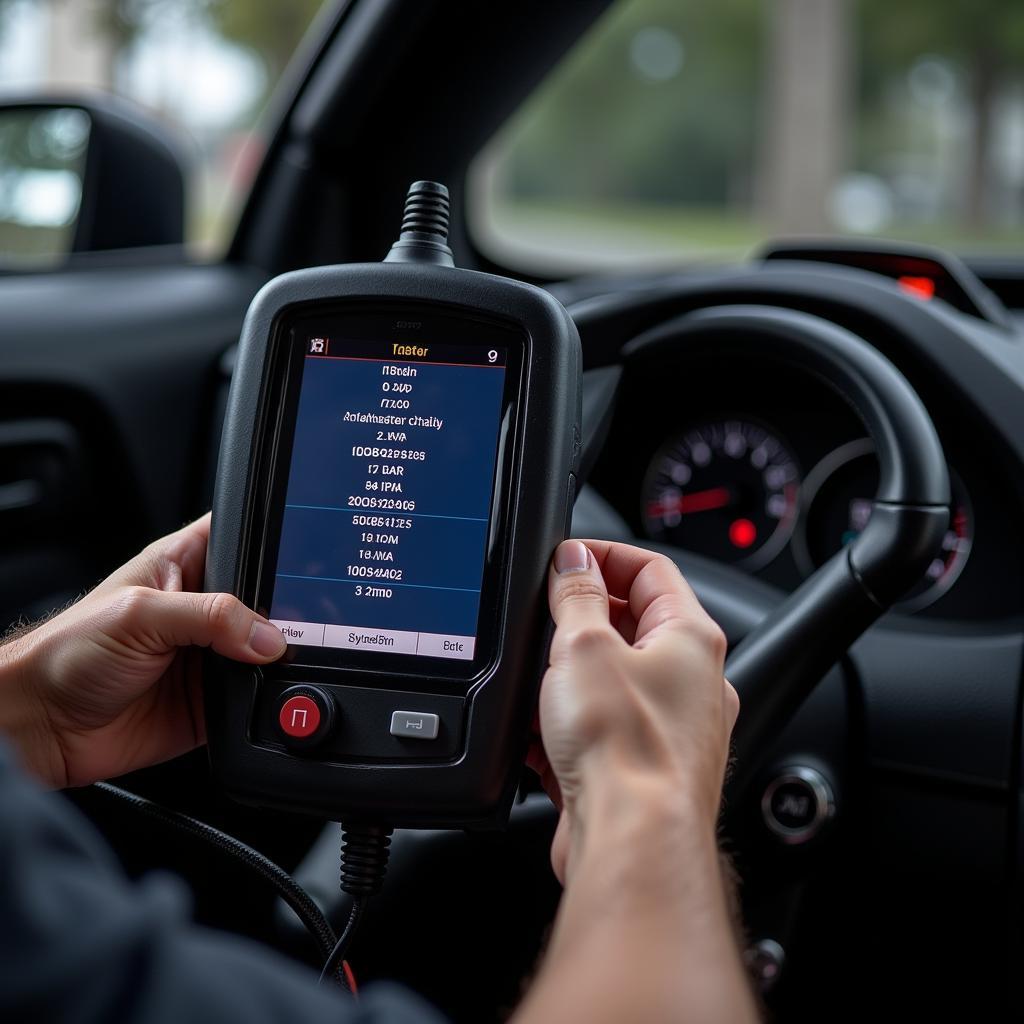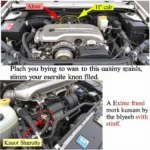Understanding your vehicle’s health can seem daunting, especially when a warning light suddenly illuminates on your dashboard. However, GM engine codes, deciphered through an OBD2 scanner, provide valuable insights into your vehicle’s condition. These codes act as a direct line of communication between your car’s computer and you, helping identify potential issues before they escalate into costly repairs.
Deciphering the Language of Your Car: What are GM Engine Codes?
GM engine codes are standardized alphanumeric codes that represent specific malfunctions detected by your vehicle’s onboard diagnostic system (OBD2). Ranging from minor hiccups like a loose gas cap to more serious concerns like engine misfires, these codes are crucial in pinpointing the root cause of the problem.
Think of it like this: your car is trying to tell you what’s wrong, but it’s speaking in a complex code. The OBD2 scanner acts as your translator, converting these codes into understandable terms. This empowers you to address issues promptly and effectively.
The Power of OBD2: A Deeper Dive
Since the mid-1990s, all gasoline-powered vehicles sold in the United States have been equipped with the OBD2 system. This standardized system provides a universal method for accessing diagnostic information, making it easier for both car owners and mechanics to understand and address vehicle issues.
A small, rectangular port, typically located under the driver’s side dashboard, serves as the gateway to this system. By connecting an OBD2 scanner to this port, you can retrieve the stored engine codes and gain valuable data about your car’s performance.
Common GM Engine Codes and Their Meanings
While countless GM engine codes exist, some occur more frequently than others. Familiarizing yourself with these common codes can provide a basic understanding of potential issues:
- P0171 (System Too Lean Bank 1): This code suggests that the engine is running lean, meaning there’s too much air and not enough fuel in the air-fuel mixture.
- P0300 (Random/Multiple Cylinder Misfire Detected): Indicating a problem with the engine’s combustion process, this code often leads to rough idling, reduced power, and decreased fuel efficiency.
- P0420 (Catalyst System Efficiency Below Threshold Bank 1): This code points to a potential problem with the catalytic converter, a crucial component responsible for reducing harmful emissions.
Expert Insight: “While these are some common GM engine codes, it’s essential to remember that each code can have various underlying causes,” says John Smith, Senior Automotive Engineer at OBDFree. “It’s crucial to diagnose the specific problem using the code as a starting point rather than relying solely on the code description.”
Going Beyond Codes: The Advantages of OBD2 Scanners
OBD2 scanners do more than just read and clear engine codes. Modern scanners, particularly those with advanced features, provide a comprehensive overview of your vehicle’s health, offering functionalities such as:
- Live Data Stream: This feature allows you to monitor various engine parameters in real time, providing valuable insights into your car’s performance and potential issues.
- Freeze Frame Data: When an engine code is triggered, the OBD2 system stores a snapshot of critical engine parameters at that specific moment. This data, known as freeze frame data, can be instrumental in diagnosing intermittent or difficult-to-replicate issues.
- Emissions Readiness Check: Before getting your vehicle inspected for emissions, an OBD2 scanner can verify if all emissions-related systems are functioning correctly.
By utilizing these advanced features, you can proactively manage your vehicle’s health, identify potential problems early on, and potentially save on costly repairs in the long run.
From Code to Solution: Taking Action with OBD2 Information
Once you’ve retrieved the GM engine codes using an OBD2 scanner, the next step is to research and understand their meaning. Numerous online resources, including OBDFree’s comprehensive database, provide detailed information on specific codes and their potential causes.
Armed with this knowledge, you can then choose the best course of action. While some codes might indicate simple fixes like tightening a gas cap, others might require the expertise of a qualified mechanic.
Expert Insight: “Don’t underestimate the importance of regular vehicle maintenance,” advises Smith. “Timely oil changes, spark plug replacements, and other routine services can prevent many engine problems and extend the life of your vehicle.”
Conclusion: Empowering Car Owners Through Knowledge
GM engine codes, deciphered through an OBD2 scanner, empower car owners with valuable insights into their vehicles’ health. This knowledge, coupled with proactive maintenance and timely repairs, ensures a smoother, safer, and potentially more cost-effective driving experience.
By understanding and addressing these codes, you’re not just fixing a car; you’re taking control of your vehicle’s well-being and embarking on a journey of informed car ownership.
Frequently Asked Questions (FAQs)
-
What is the difference between a check engine light and a service engine soon light? Both lights indicate a potential issue with your vehicle’s engine or emissions system. However, a check engine light typically signifies a more serious problem that requires immediate attention, while a service engine soon light may indicate a less urgent issue, such as a loose gas cap.
-
Can I drive my car with the check engine light on? While it’s technically possible to drive short distances with the check engine light on, it’s not recommended. Ignoring this warning sign could lead to further engine damage and more costly repairs down the line.
-
Will disconnecting the battery reset the check engine light? Disconnecting the battery might temporarily reset the check engine light, but it won’t address the underlying issue. The light will reappear if the problem persists.
-
How often should I get my car’s OBD2 system checked? It’s generally a good practice to have your vehicle’s OBD2 system checked at least once a year or as part of your regular maintenance schedule.
-
Can I use any OBD2 scanner on my GM vehicle? While most standard OBD2 scanners can retrieve basic engine codes, some advanced features and functionalities might require scanners specifically designed for GM vehicles.
If you have further questions or need assistance with connecting an OBD2 scanner to your Mercedes S550, exploring the features of a Torque OBD2 scanner, or learning about free OBD2 program options, our comprehensive resources are here to help. You can also find helpful information about 2016 Chevy Colorado OBD2 location and the benefits of a Torque WiFi OBD2 scanner.
Remember, understanding your vehicle’s health is key to a smooth and enjoyable driving experience.


